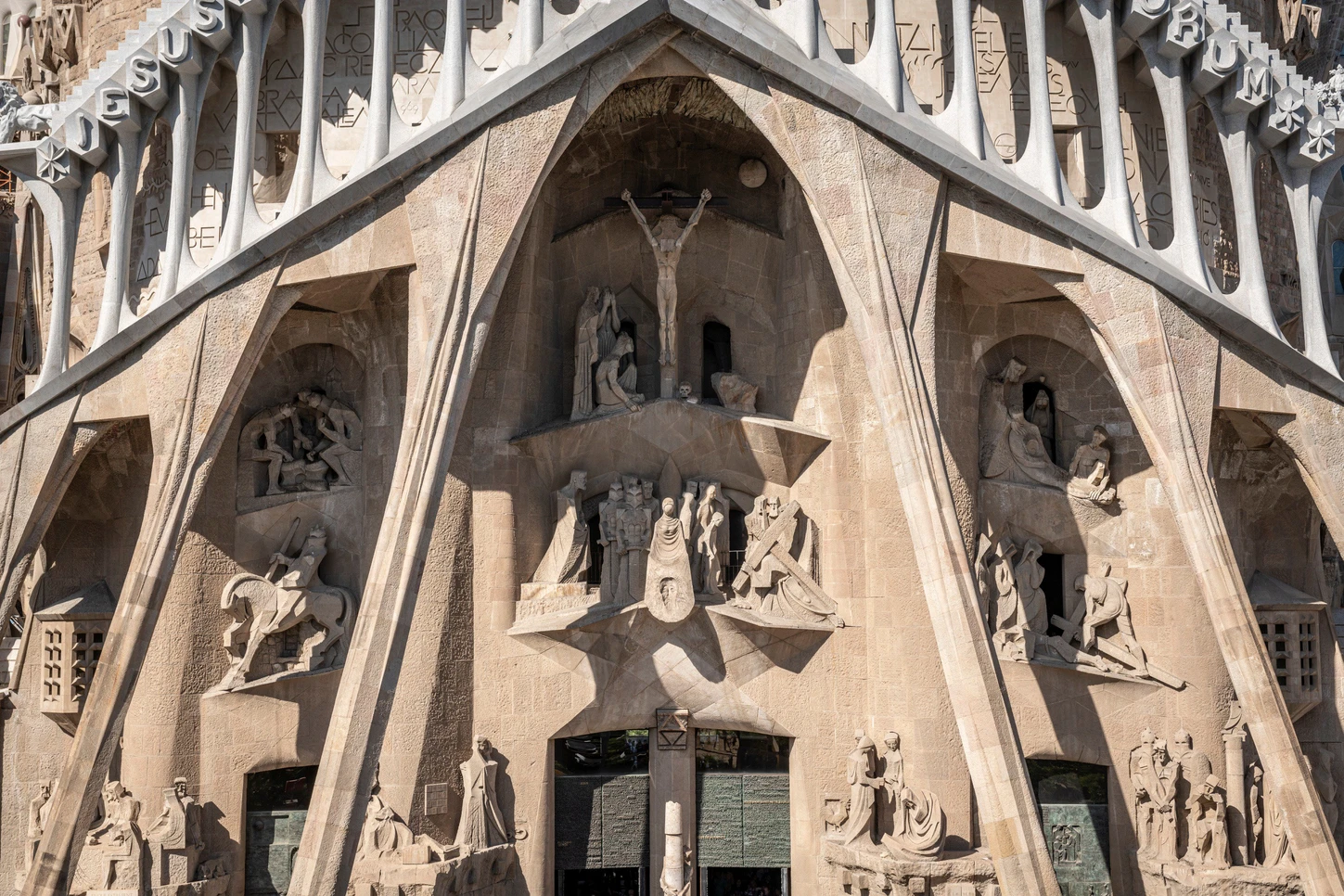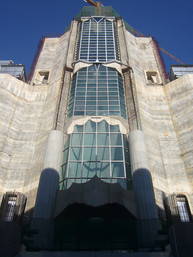If there is one regret that I have about my trip to Barcelona, it's the fact that I did not get the chance to see the interior of the famed La Sagrada Familia, a monumental church dedicated to the Holy Family of Jesus, Mary, and Joseph.
I know, I know...you are probably thinking what a big mistake that was because it's THAT one place you should NOT miss when in the city. It is considered Barcelona's crown jewel! Some even say it is practically illegal to go to Barcelona without visiting La Sagrada Familia.
But to give you a little bit of context, I went to Barcelona in 2013 as part of a pilgrimage tour, which meant that the focus was on religious shrines. Though La Sagrada Familia is a Basilica, it is more of a museum than a working church. Masses are held there only once every Sunday and on holy days of obligation. Most people go there to see the architecture and the art work, rather than pray and worship. Hence, while we were given the opportunity to visit it, the tour company did not make special arrangements in terms of pre-purchased group tickets or fast-track entrance. It was something that we had to do on our own during our free time.
Of course, it was on my list, but my travel amigas and I failed to realize we were in Barcelona at the peak of the summer tourist season and that the line ups to get inside would be crazy. None of us thought about getting our tickets online ahead of time. So yes, you could blame us for not doing our homework. Big fail! However, we at least had the chance to admire its exterior. After all, the basilica is a magnificent work of art inside and out.
Our tour bus dropped us off at the square across from the Basilica in the early morning. Our Tour Director said that the bus would be back at lunch time to pick us up at the same spot. He emphasized the limited time that we had and advised that we use it wisely. He even suggested we grab a bite around the area after we had our look around because as soon as we reach the hotel that afternoon, we would only have approximately half an hour to freshen up for our excursion to Montserrat.
My amigas and I wasted no time. We crossed the street and headed directly to the church façade. Our excitement quickly turned into disappointment when we saw the very, very long line-up of tourists who were waiting to get inside. One of them, who was halfway down the line, exclaimed that he arrived at seven in the morning to have a head start, but found out several hundred other people had the same idea. We were certain there was no way we could see the interior of the church, unless we would plan on staying there the whole day and skipping our afternoon drive to Montserrat. We did not want to do that.
So, we decided to make the best of the time we had by circling the Basilica and studying each of its façades (yes, with an s, because it has three) in great detail.
Why is this church such a big deal in the first place? Well, its history alone is very interesting.
The Basilica of the Sagrada Familia's construction began in 1882 based on the plan drawn up by diocese architect Francisco de Paula del Villar. In 1833, Antoni Gaudi, a young architect, was commissioned to take over the project because del Villar had a disagreement with Jose Maria Bocabella, the president of the Holy Brotherhood in-charge of the church.
Gaudi assumed this as his life’s work and devoted his efforts in building a great cathedral (even though this church didn’t host a bishop) for he was convinced that someday, Barcelona will be known for this outstanding structure (If he could only see the number of people wanting to see this church now!). Sadly, he did not live to complete his project. He unexpectedly died from an accident. Until now, the construction is ongoing, with its completion scheduled for 2026, the 100th anniversary of his death.
One might wonder why it’s taking so long to finish the project. You see, Gaudi, as a practitioner of Catalan modernism, rarely drew detailed plans, instead preferring to create three-dimensional scale models and moulding the details as he conceived them. He had a style that is totally his own, going beyond Gothic, Gothic Revival, and Modernism. It doesn’t have a specific category or classification, but all of his work was heavily influenced by his passions in life: architecture, nature, and religion, and is inspired by a myriad of things, from Oriental art to science, most specifically, geometry. The result is a unique blend of technical perfection with aesthetic value…a masterpiece of beauty and structural innovation. And because of its very personal nature, he had never really created a school nor taught his many assistants and helpers in his lifetime. He did not leave plans or written documents either. Thus, with his untimely demise, it was difficult for anyone to pick-up his projects. But some of his subordinates adopted his innovations, and his artistic influence has inspired the work of a great many admirers who have taken the helm to complete his work.
Just by looking at the façades of La Sagrada Familia, one will never doubt that this magnum opus is indeed the synthesis of his architectural evolution. While the crypt and the apse were executed in the Gothic style, the rest of the church is conceived in an organic style which emphasizes natural shapes and carries an abundance of ruled surfaces.
The church is in the shape of a Latin cross and thus, was designed to have three façades, with two (the Nativity Façade and the Passion Façade) corresponding to the arms of the cross. The third (the Glory Façade) is situated at the start of the nave. All the artistic elements used in the design are steeped in religious symbolism.
We started our self-guided exterior tour in the Nativity Façade. This façade (my personal favourite), which was completed first, has three portals related to the Christian themes of faith, hope, and charity. The iconography depicts biographical events pertaining to the birth, childhood, and youth of Jesus. Between the portals are elaborate pillars crowned by palm trees and resting on two large turtles made of stone. These are obviously Oriental-inspired, as the turtles are the Chinese symbols of immutability and continuity. There are also two chameleons on both sides of the great façade, which in contrast, symbolize the constant change in nature. Between the portals above the columns, there are angels holding trumpets announcing the “end of the world” and above them, the astrological zodiac spans out showing the 12 signs of the constellations. I have never seen a church portal like this. This eclectic design certainly exceeds the peculiarity of the Manueline architecture I saw in Portugal.
There are four spires on this façade (The church should have a total of 12, symbolizing the 12 apostles and eight have been, so far, completed). These four were actually finished before Gaudi’s death. Each of these 100-metre towers have pinnacles decorated with colourful mosaics, and the names and statues of the apostles seated on pedestals, appear on the towers.
As well, high up on this façade is a spire with a cypress tree that symbolizes the “tree of life.” There is a pelican at the foot of this tree which is said to symbolize the Host. There are also angels sitting at the bottom, holding chalices, to remind us of the Eucharist. At the apex of the tree, the letter T (or Tau) stands for God (as the first letter of God's name in the Greek alphabet). It is red with diagonal bars crossing it forming an X, representing Christ's name. A Dove at the top with outspread wings represents the Holy Spirit. Thus, the Three Persons of the Trinity are personified at the top of the "tree of life."
We walked around to check out the next façade – the Passion Façade. Gaudí designed this portal during a serious illness in 1911. This relatively plain façade lacks decoration with total emphasis on the sculptural groupings spaced along the façade. These sculptures focus on the last days of Jesus' life and are arranged chronologically, moving from the bottom left to the right, then right to left in the middle register, and then back right on the top level--in an enormous "S". The sculptural narrative and characters are striking for their simplicity and drama, with angular facets conveying torment and pain. The figures are reminiscent of Expressionism, an art style preferred by Gaudí. The pillars of the canopy are reminiscent of bones. Gaudí passed away before this façade and the portal were completed.
Next, we checked the Glory Façade, the newest of the three. It is supposed to represent Christ’s eternal glory and will feature scenes of Christ’s rise to heaven and eternal bliss. This one is not finished yet (construction began only in 2002), but upon completion, it will be the largest and the most magnificent one. The spires are also going to be higher than those of the other façades.
Gaudi was well aware that construction of this façade would not be completed in his lifetime. Hence, he drew just a few sketches with a general idea of what his vision and plan were. On the portals, Gaudi wanted to show the last four events in a person’s life – Death, The Last Judgment, Hell, and Heaven. He envisioned tall columns dedicated to the seven holy gifts and that will depict the seven deadly gifts at the bottom and the seven heavenly virtues at the top. Seven entrances representing the seven sacraments of Baptism, Confirmation, Eucharist, Reconciliation, Holy Order, Marriage, and Anointing of the Sick will lead to the church. Someday, I hope to go back to see the completed version.
And with that, our exterior tour ended and we were left wanting. After having a taste of Gaudi's artistic vision, I was eager to see more inside. Unfortunately, it was not possible at that time.
My amigas shared my sentiments. We all made a promise that one day, we will go back to Barcelona and that this will be the first item on the itinerary.
Photo Credits:
lonelyplanet.com, bbc.com, blog.sagradafamilia.org, usatoday.com, citytoursbarcelona.com, barcelonacheckin.com, theculturetrip.com, livinginflux.com, covenant.livingchurch.org, Gerardo Nunez (Wikipedia)








































Comments